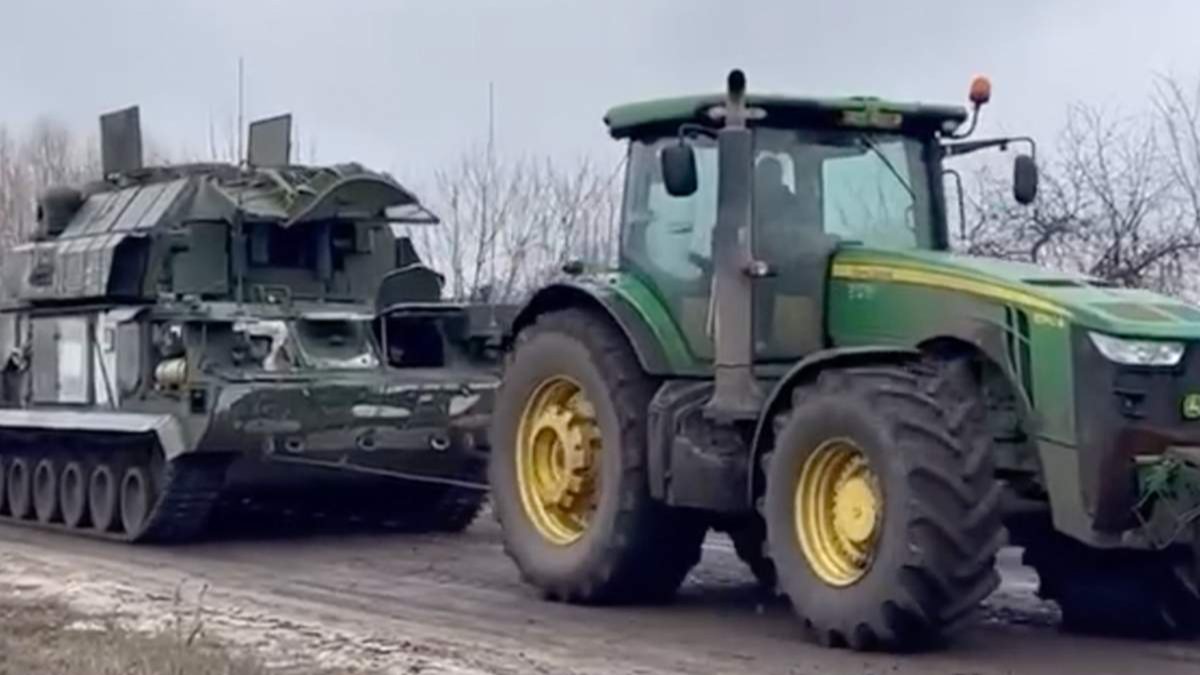“What’s that noise over there? Air defence?”
Two old ladies shopping at the market stalls not far from where I live take a moment to listen to the sounds that seem to be coming from under the ground.
“No way, it’s got to be demining.”
They both nod in agreement and go their separate ways: one woman needs berries, the other one is looking for cottage cheese. The air-raid warning that followed the blasts does not really make much of a difference: the vendors continue serving their customers as usual. This is not because the Ukrainians have nerves of steel. They simply got used to the danger. Emergency workers disapprove of this behaviour, but there is nothing to be done.

Photo: Sergey Koshman
The demining of the Kyiv region is well underway. Besides Irpin and Bucha, bomb squads are sweeping the positions previously held by Russian soldiers in Myrotske and Vorzel, dirt roads near the Kotsyubynske settlement, rivers in the area of Lyutizh, agricultural lands in Kozyntsi and Dibrova… There are too many places to count: the list seems endless. The Kyiv region is considered one of the areas of Ukraine with the highest mine count, followed by the Kharkiv, Chernihiv and Sumy regions. We do not even count the Donetsk and Luhansk regions for now.
There is no information on the exact area of Ukraine where explosives have been planted a result of the Russian aggression.
Ukraine’s Interior Ministry and emergency services report that half the country’s territory, or 300,000 square kilometres, is considered a mined area. The Defence Ministry and the Ukrainian Deminers Association offer a lower figure of 130,000 square kilometres, adding that this covers a larger area than the territory of Greece, or an area akin to two Croatias. Experts agree that one day of hostilities equals a month of minesweeping. Optimistic forecasts suggest that it will take specialists up to 10 years to eliminate the consequences of the Russian invasion, while the more realistic projections state that it might take up to 20 years. That is, if all hostilities stop tomorrow.
The demining of agricultural lands is considered humanitarian mine clearance, which differs from battle area clearance and operational demining. This year’s sowing campaign was held in dangerous conditions: there was no guarantee that there were no mines or ordnances buried deep underground, and that a tractor would not dig up an explosive even after the bomb squad had cleared the territory. Only in the Kyiv region, there was at least a dozen tragic incidents with tractor drivers in April and May. In some areas of the Kharkiv region, the sowing campaign was held under the protection of self-propelled artillery systems. Russian helicopters were attacking tractor drivers from the air. To make sure that the bread had enough iron, of course.
By the way, the fields are usually not the first to be demined. Local officials first ask the emergency services to “clean up” local settlements, residential buildings, roads, power lines and water supply systems. Agricultural lands are not the top priority. I am describing this in detail just to remind you that Ukraine is in the top five largest exporters of grain in the world. The Russian aggression is quite literally making it harder for people to put food on the table.
An airborne mine detector
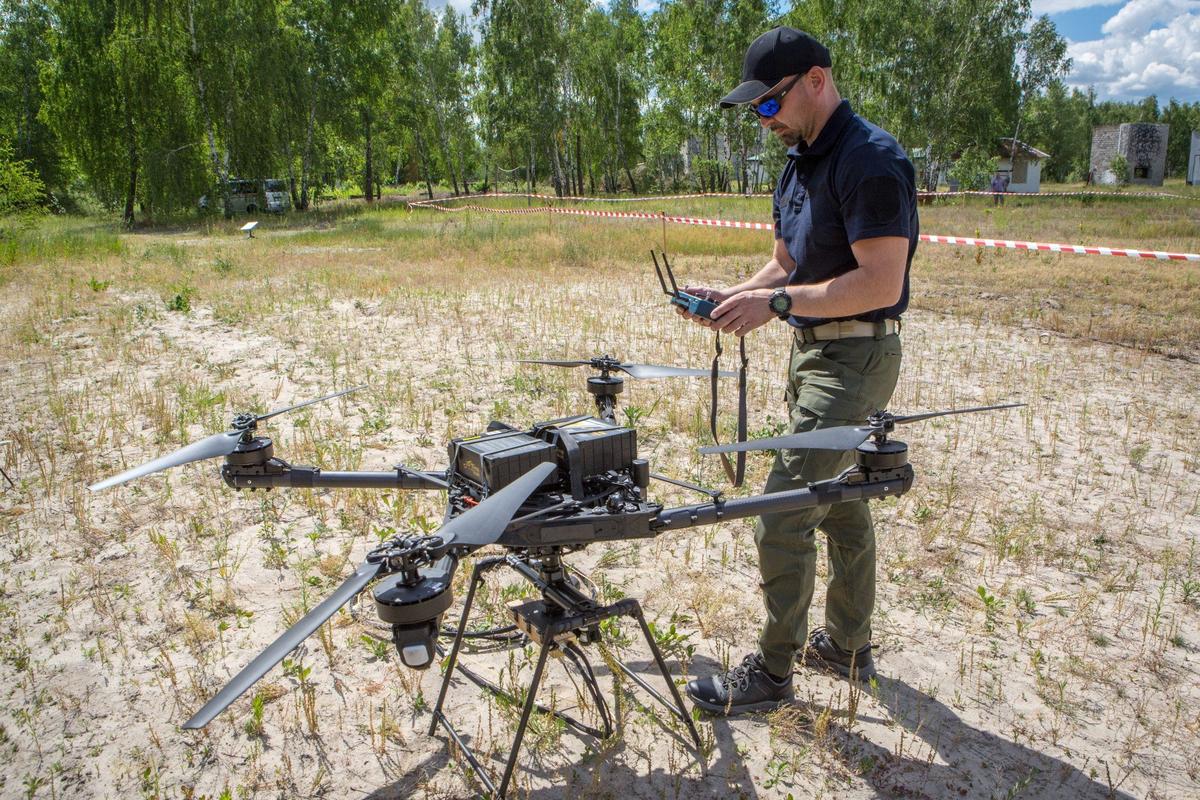
Photo: Natalya Kravchuk
We are on our way to the testing ground of the State Emergency Service of Ukraine in Dmytrivka, a village near Kyiv. There, we will see an innovative device, an airborne AI mine detector, in action. The occupants were pushed out of Dmytrivka in late March. There were tank fights practically on every corner. The Ukrainians piled up what was left of the Russian equipment on the side of the road. It is crazy how fast the burned-out tanks get covered in rust! The tanks seem like props from a war film set against the backdrop of blooming bushes, but the locals drive past them without a second thought. Very rarely, people would get out of their cars to take a picture or to kick the rusty tanks. Are they used to them by now? Or do they turn away in disdain?
One of the hangars belonging to the State Emergency Service burned down in the hostilities, with only the carcass left. The windows in the administrative building are empty and black: the emergency workers were affected by the war as much as the local residents. A representative of US-based drone manufacturing company DraganFly is trying to keep it professional, but he is still visibly shaken by the reports of what happened here not so long ago and by what he has seen. He also seems impressed with the attention to detail of the drone’s future users.
The drone, equipped with a magnetometer, is launched over a sunburnt field surrounded by police tape, like the one used for car accidents. There is an air bomb sticking out of the ground, clearly seen from the platform we are standing on. The rest is hidden underground. The reporters seem disappointed: the drone did not make a single sound to alert us about the bomb. It was just buzzing around the field, at times stopping in mid-air, as if mulling something over.
The company representative says that the results will be available only in 24 hours. The automated system will superimpose the data received from the detector to produce a 2D mine map that will show the location of the bombs with the accuracy of up to one centimetre. Due to weather conditions, mines can migrate: someone’s death may be waiting for the right moment, buried deep underground.
It takes the drone about an hour to scan one hectare of a regular field. It is also self-learning. The longer it flies, the better it is at fulfilling tasks. It does not even need a trained operator: anyone can be taught to fly the drone in a day. It takes regular bomb squads much longer to investigate the territory, and the results will not be as reliable.
“If we had had equipment like this in the Kyiv region in spring, during the sowing, it would have turned out different,” Volodymyr Petrochenkov, a deminer with 20 years of experience, says.

Oleh Borysenko. Photo: Natalya Kravchuk
Oleh Borysenko, head of Ukraine’s parliamentary environment policy committee, is not so quick to sing praises to the drone. “How well did it do? We’ll find out when we see the map.”
He noted, however,
that Ukraine values the lives of its people too much to demine thousands of hectares of land without special equipment. He also agrees that there will be no collection of harvest from the lands with cruise missiles sticking out of them for the same reason:
people’s lives are more important.
“We’re at war. And we can’t achieve the same level of economic activity. Unfortunately, the agricultural sector will suffer major losses this year.”
And this is not just because the Ukrainian fields have turned into battlefields and minefields…
Vera the Pirate and Nadezhda the Smuggler
International organisations have been unable to protect Ukraine’s legal right to sell its produce internationally during this war, Kateryna Yaresko, head of the Social Communications Management Department at the Kharkiv National University of Economics, a volunteer and a reporter with Myrotvorets News, admits.
Numerous cases of looting among Russian soldiers in Ukraine — the participants of the “special operation” stole washing machines, fridges, plasma TVs, even women’s underwear — are just the tip of the iceberg compared to the scale of the pillage in Ukraine committed by Russia as a state entity. I am looking at the materials published by the SeaKrime investigative journalism project, the screenshots from the Marine Traffic ship tracking website, and I am seeing entire caravans with grain travelling from the occupied Crimea to Turkey every day without fail.
Here's an example: a cargo ship named Vera (a common female name that means faith in Russian — translator’s note) sailing under the Russian flag. Vera entered Sevastopol on 8 May with her automatic identification systems (AIS) transponder turned off, loaded the grain at the Avlita grain terminal, and left the port on 9 May. The ship appeared on the AIS the next day with her status showing up as loaded, travelling to Turkey’s Samsun.
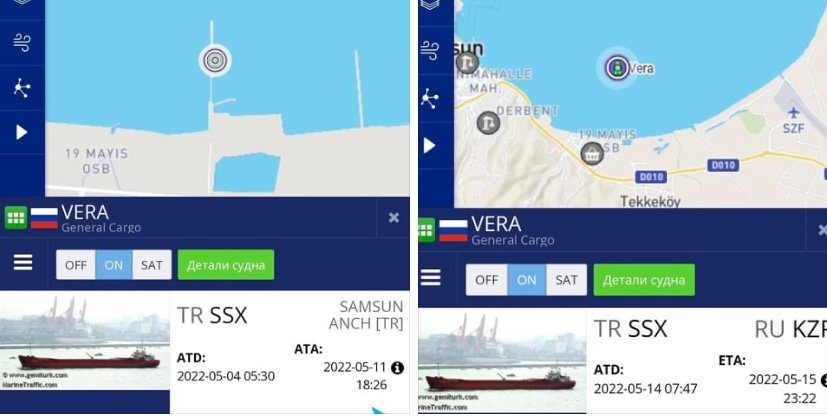
Screenshots from the Myrotvorets website
Another Russian ship by the name of Nadezhda (also a common female name, it means hope in Russian — translator’s note), followed Vera’s example. On 10 May, it entered the Kerch Commercial Sea Port in Crimea, loaded up 2,800 tonnes of grain and left the port for Samsun. By that time, Vera the Thief was already rushing back to Crimea for another portion of cargo. On 14 May, another Russian cargo vessel Sormovskiy-48 was caught red-handed. The ship turned off its AIS transponder, entered Kerch, loaded up 3,000 tonnes of corn and left for Samsun.
Matros Pozynich, a bulk carrier sailing under the Russian flag, was caught transporting stolen grain in late April. The vessel planned to use the same scheme to deliver 27,000 tonnes of grain to the Egyptian port of Alexandria.
However, the outrage expressed by Ukraine forced Egypt to go back on the deal, so Matros was forced to make a turn towards Syria, where it was welcomed with open arms.
Russia’s Matros Koshka (which means Sailor the Cat in Russian — translator’s note) loaded the cargo in Sevastopol in late May and later transported it to the Middle East without a hitch, unloading with the AIS turned off, possibly in Syria.
What’s the deal with switching off the AIS? The captain of the ship realises that they are breaking the law, and tries to cover up the smuggling of cargo in large quantities by violating a state border. This is a violation of the International Maritime Law. The vessel involved in this act can be detained and be subject to severe sanctions. Ukraine has accused Russia of smuggling many times, also condemning the decision of some countries to turn a blind eye to where the goods come from. The buyers of stolen goods also bear responsibility, Vasyl Bodnar, Ambassador of Ukraine to Turkey, said in no uncertain terms. Besides, the US formally warned 14 countries that they are receiving the grain stolen from Ukraine.
Olga Musafirova (Novaya Gazeta. Europe): Did it change anything?
Kateryna Yaresko: Nothing. It’s still happening. Sormovskiy-48 delivered corn to Samsun again and then came back for another batch. Nadezhda has also recently loaded up in Kerch.
(Our readers will understand the scale of what is happening better if we mention that SeaKrime has been monitoring Russia’s smuggling of agricultural produce from the occupied Crimea not since 24 February, 2022, but since 2016. There are over 500 publications on the website.)
The vessels started transporting grain to Turkey last autumn. But the full-scale aggression led to a rise in the amount of grain and corn transported via sea routes. In January, about 40 tonnes of grain were transported from Sevastopol. In March and April, there were 102 and 109 tonnes of grain respectively. In May, they transported even more. And then there’s Kerch, which transported about half of these amounts. The Ukrainian government offers a total figure of 400,000 to half a million tonnes of grain stolen from Ukraine, which led to $200 million in losses. And then there’s the question: why is there so much grain on the peninsula? As we all know very well, the Crimeans do not grow this much grain. The Crimean Bridge is now transporting different kinds of cargo to supply the military aggression, the cargo load is enormous, as there are no other logistics routes. The airport is shut down. So, delivering grain from Kuban (a geographic region in Southern Russia — translator’s note) would be very difficult right now. This means that we can safely assume that Russia is transporting the produce, grain for the most part, from the occupied Kherson and Zaporizhzhia regions.
But we do not have any evidence. It is difficult and dangerous to report from the occupied territories.
Grain blockade
I’d like to ask you a rhetorical question. On the one hand, Turkey is happy to accept Ukrainian grain expropriated by Russia, and on the other hand, it offers to act as a mediator between Kyiv and Moscow to unblock Ukrainian ports and to help Ukraine sell its produce independently. The UN welcomes any agreement that can help avoid global hunger. What is the meaning of this?
We were shocked by the double standards back in 2016: Ukraine’s Crimea was occupied by Russia, the ports were closed, but ships entered them even under the flags of the EU, namely, Bulgaria.
Turkey, Greece and Bulgaria regularly accepted scrap metal transported from the peninsula. Ukrainian reporters have never been silent about this. We publish as much evidence as we can on our website, the Ukrainian law enforcement has the opportunity to initiate criminal proceedings, diplomats are using their channels. But the reality of the situation is still the same.
According to Kateryna, in 2017, Ankara, due to a wide range of factors, approved a circular banning navigation between Turkish ports and the occupied Crimea. At first, Turkey adhered to the document, although there were some violations. At least it did not allow the smuggling of cargo from the peninsula. Ukraine was grateful to Turkey for its solidarity and respect for Ukraine’s state sovereignty up until the autumn of 2021, when the circular was suddenly abandoned.
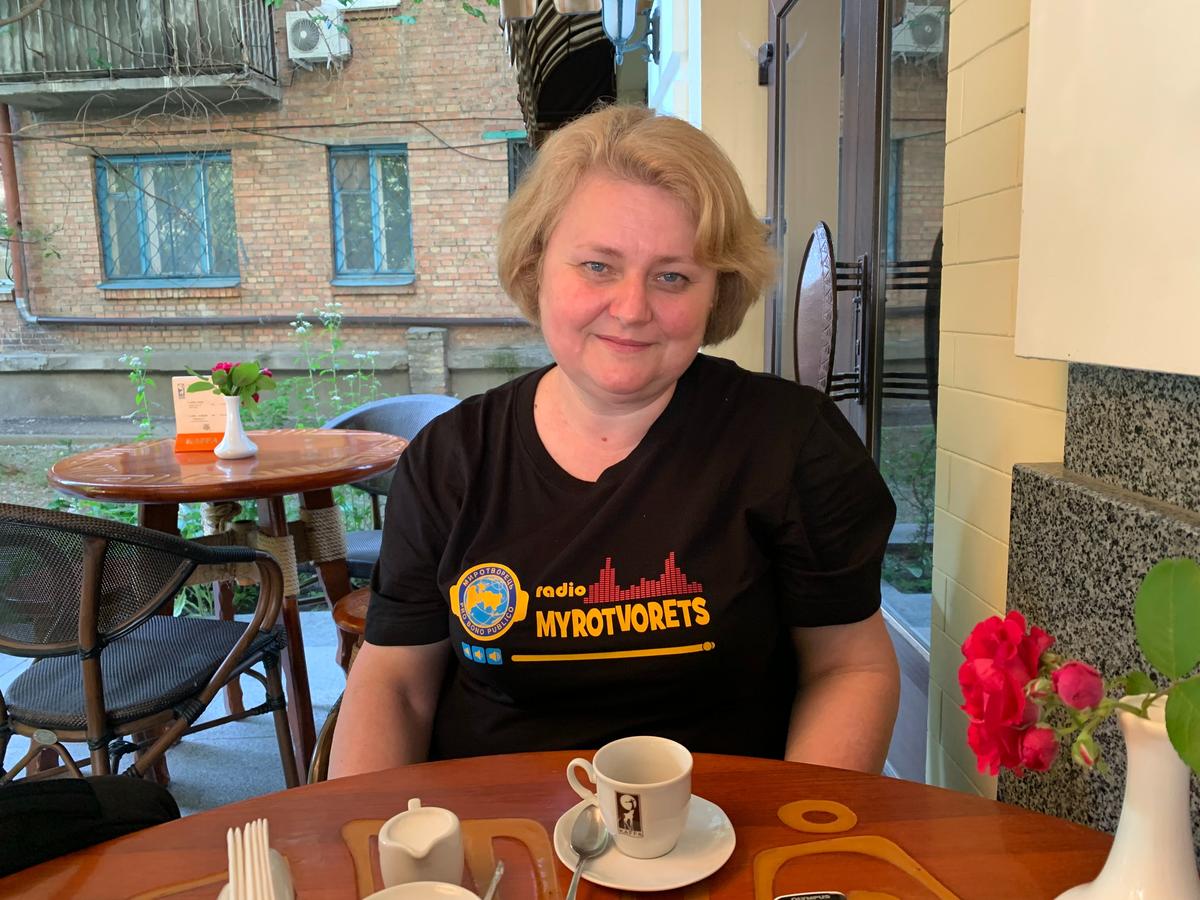
Kateryna Yaresko
Here's some data monitoring from the Russian Grain Union. Experts compared May 2021 and May 2022, concluding that Russia has doubled its grain export: 675,000 tonnes compared to 1.26 mln tonnes. This falls in line with your suspicions: Kherson and Zaporizhzhia grain is now being sold without a “produced in Ukraine” stamp.
Russia has basically admitted to shamelessly exporting Ukrainian grain. The pro-Kremlin media reported that the first freight train with 11 cars left Melitopol for Crimea. The government of the so-called “LPR” (Luhansk “people’s republic” — translator’s note) also boasted the fact that 50 train cars had left for Russia with over 3,000 tonnes of cargo, and so on.
Yaresko reminded that the grain has its owners, whom the occupants need to communicate with somehow. Some had their produce taken away or seized, some were offered small sums of money. But everyone was warned that they need to register in accordance with the Russian law to get a permit for further work. The farmers that agreed to do this (you can’t take your land share with you when you evacuate!) are considered collaborators under Ukrainian law. They are facing criminal charges in Ukraine. “It’s a terrible situation for the people,” Kateryna Yaresko agrees.
It is unclear how many farmers agreed to play by the rules of the occupants, and how many handed over their grain: firstly, because if they had refused, it would have gone rotten, and secondly, because they needed to free up the space for the new harvest. However, the amount of grain transported to Kerch and Sevastopol is rising. The Crimean ports are hard at work.
Kateryna Yaresko: Unfortunately, the UN Security Council and other international organisations have been helpless in the face of Russia’s hybrid aggression in the form of pillaging. They haven’t reviewed their approaches. This is why the Ukrainians are trying to use the means of influence in their arsenal, at the very least.
Olga Musafirova (Novaya Gazeta. Europe): Russia’s plan for saving the world looks like this: Russia is ready to feed the hungry on its own, but first, the sanctions must be lifted. Ukraine won’t accept this option. Turkey, as we mentioned earlier, offers Kyiv and Moscow to meet each other halfway. The Pentagon put forward an idea of military convoys, like during the Second World War. There aren’t many options, and there is no time for mulling this over, the harvest is approaching us.
We are able to export some of it by land transport through Romania. Ukrainian ports on the Danube River are working. The first batch, 18,000 tonnes, left through the Baltic Sea a couple of days ago. Will this be enough? We do not have European standard railways, and we are cut off from the sea: in a sense, we’re in a blockade as an agricultural country.
So, Turkish mediation then?
Right now, the ports are mined as a defence measure against Russian paratroopers. Turkey cannot guarantee that Russia will not use the demining as an “invitation” to take Odesa, for example. While the hostilities continue, the question of security trumps grain export, no matter how important it may be.
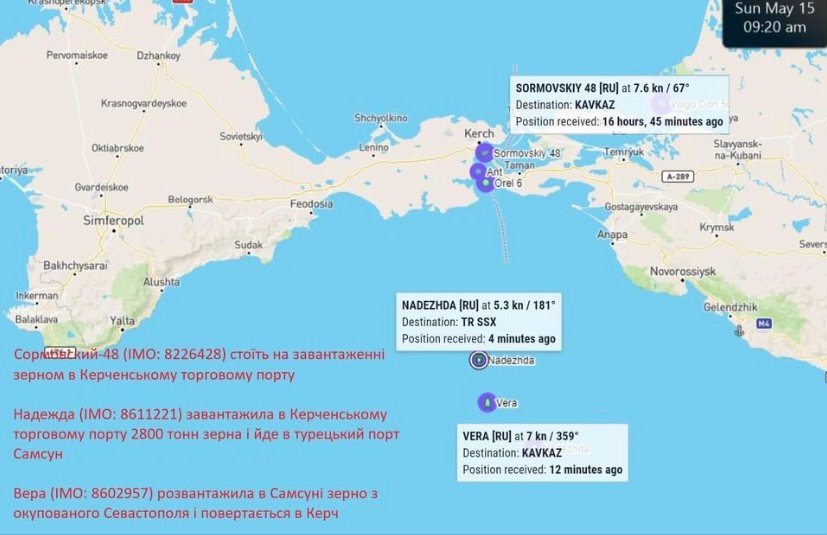
Screenshots from the Myrotvorets website
‘The world will pay more for less’
Oleg Nivievskyi, Vice President for Economic Education at the Kyiv School of Economics, explains why the export of Ukrainian grain plays an important role on the global market right now.
Olga Musafirova (Novaya Gazeta. Europe): I’ve heard experts say that the war has seriously affected the grain market. Because grain is mainly sowed in central and southern regions [of Ukraine], and they were either occupied or involved in active combat for the entire spring. This is why this year’s harvest will be down about 30 mln tonnes compared to last year. What does this mean for Ukraine and for the world?
Oleg Nivievskyi: When it comes to Ukraine’s food security, it doesn’t mean much. The concerns about hunger are usually tied to one question: will we have enough grain for ourselves? The demand and consumption within the country does not surpass 5 million tonnes. So even if the harvest goes down 30 to 40 percent, we will still have enough for domestic consumption and even something left for export.
Last season, our grain export was expected at the level of about 22 mln tonnes. Right now, the figure will be lower, but still, it’s a significant number. We’re fine in terms of food security. But the farmers and the agricultural producers who did not sow and/or will not be able to collect their harvest will suffer losses, of course. Even those who sowed the grain in autumn, because they are working with winter crops, still face an unpredictable situation due to blocked ports and the surplus of grain in the country. The domestic prices for grain have dropped overall. People are getting less than what they did before the war, although the global prices nearly doubled for the same reason, because of the war. The price at the Paris Bourse ranges from 200 to 400 euro.
And now let’s talk globally. We export quite a lot of grain, up to 10 percent of the global market. Russia is the largest exporter: we export 20 mln tonnes, Russia exports 40 mln. At least, these were the expectations for this season. But our export level is enough for other countries to encounter serious problems if there is a lack of Ukrainian grain. They will pay more and get less.
The global harvest is expected to be rather small this year: firstly, due to the war, and secondly, due to weather conditions. This causes the prices to rise. The combination of these two factors leads to a critical dependence on Ukrainian grain this year. If we were talking about a more favourable period, our input would not be considered this significant. But when there is a general lack of grain, every million tonnes counts.
Is it true that Ukrainian farmers had to replace corn, which is usually planted in spring, with soya? Corn requires more expenses and more care; soya is easier to deal with. What will this lead to?
The fears are unfounded. Even if less corn is planted, there will be enough of it for animal farming. We mainly export corn: over 30 mln tonnes are exported. As far as I know, there is less corn because the farmers wanted to play it safe in case the ports are blocked for a long time. Soya doesn’t depend as much on the ports, it can be exported by land transport or consumed domestically.
So, the main issue that farmers face during the war is not planting the crops, but selling them?
Yes, that’s right. And not just selling them, but getting a good profit. Here’s what’s going on: even if you manage to sell the grain, its price will be lower than it was before the war. That is, we sold it, we got the revenue, but we can’t cover our expenses.
Let’s use sunflower oil as an example. There are many sunflower fields in Ukraine, but sunflower oil production is quite a risky business right now. We export 96% of sunflower oil. Therefore, sunflower harvesters are not in a good situation right now. Oil factories used to buy sunflower seeds for 23,000 hryvnias a tonne, and now they are buying the same amount for 50% less. The reason is the same: the ports are blocked, the logistics are disrupted, and the price for logistics services has risen. So, the problem isn’t just selling the goods, it’s getting a good price for them.
I often see news about Russian missiles destroying another granary or a grain elevator. Is there enough of them left in the country?
Thankfully, there is no acute deficit of granaries so far. They struck port terminals, too. But that’s not the point: the granaries need to be emptied as soon as possible to accommodate newly harvested grain. And there’s nowhere to transport the previous harvest. We can’t export it to the required extent.
Considering what you’ve just told us, Oleg, how much will bread, sunflower oil and sugar cost at supermarkets in autumn?
That’s an interesting question. It’s hard to predict the prices, but they definitely won’t be cheaper. Although domestic grain can be cheaper, bread production includes energy prices, fuel prices and so on. A 10-20% rise is inevitable, I think.
P.S.
While the article was getting ready for publication, it was reported that EU states would consider providing temporary grain storage to Ukraine “in the form of modular structures and plastic bags”, Ukrainian deputy agriculture minister Markiyan Dmytrasevych said. This will help export the 20 mln tonnes of grain currently “stuck” in Ukraine, to decrease global food prices and ensure that the new harvest is safe from Russian missiles.
Next week, a delegation of EU officials plans to visit border checkpoints between Ukraine and Poland to make sure that agricultural produce goes through the border as swiftly as possible. The sides seem to have found a solution: the plastic bags with grain are safe from Russian bombs on the territory of the European Union.
